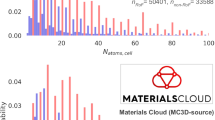Abstract
TEST cells for ultra-high-pressure apparatus of the ‘belt’ or ‘anvil’ types1 are typically made from pyrophyllite, a naturally occurring aluminium silicate. It is unlikely, however, that this material possesses an ideal combination of mechanical properties for this purpose, a view which is supported by the shape of the load/pressure calibration curve. Fig. 1 (curve A) shows this experimental relation for a 0.75-in. edge National Bureau of Standards type tetrahedral anvil apparatus using pyrophyllite tetrahedra. The usual resistance transitions in bismuth at 25.4 kbars (ref. 2), thallium at 36.7 kbars (ref. 2), and barium at 59 kbars (ref. 3) were used, with the specimen geometry shown. It will be noted that although at 25.4 kbars loads close to the nominal pressure (that is, load/anvil area) line B are obtained, at higher pressure there is a more or less linear fall-off towards high loads, the efficiency of pressure generation falling away rapidly. No explanation of this has as yet been published, but two likely hypotheses may be put forward: either (a) it is due to the load on the compressible gaskets, or (b) it is due to stress difference in the pyrophyllite (which can be high at high pressures)1, since the maximum principal stress would be expected to be normal to the anvil face in the pyrophyllite just below the surface. Experiments have been made with specially profiled and lubricated anvils4: these indicate that gasket loads are probably not significant throughout the pressure range, so that (b) is the more likely hypothesis. Since this involves a fundamental mechanical property, an alternative test cell material was sought with a different relation between shear strength and compressibility.
This is a preview of subscription content, access via your institution
Access options
Subscribe to this journal
Receive 51 print issues and online access
$199.00 per year
only $3.90 per issue
Buy this article
- Purchase on Springer Link
- Instant access to full article PDF
Prices may be subject to local taxes which are calculated during checkout
Similar content being viewed by others
References
In Modern Very High Pressure Techniques, edit. by Wentorf, R. H., 1 (Butterworths, London, 1962).
Kennedy, G. C., and Lamori, P. N., J. Geophys. Res., 67, 851 (1962).
Kennedy, G. C., see High Pressure Measurement, edit. by Giardini, A. A., and Lloyd, E. C., 386 (Butterworths, Washington, 1963).
To be published.
In Modern Very High Pressure Techniques, edit. by Wentorf, R. H., 229 (Butterworths, London, 1962).
In High Pressure Measurement, edit. by Giardini, A. A., and Lloyd, E, C., 315 (Butterworths, Washington, 1963).
Author information
Authors and Affiliations
Rights and permissions
About this article
Cite this article
ASHCROFT, K., GOODMAN, C. & LEES, J. Improved Test Cell Material for the Tetrahedral Anvil Apparatus. Nature 205, 685–686 (1965). https://doi.org/10.1038/205685a0
Published:
Issue Date:
DOI: https://doi.org/10.1038/205685a0
Comments
By submitting a comment you agree to abide by our Terms and Community Guidelines. If you find something abusive or that does not comply with our terms or guidelines please flag it as inappropriate.



